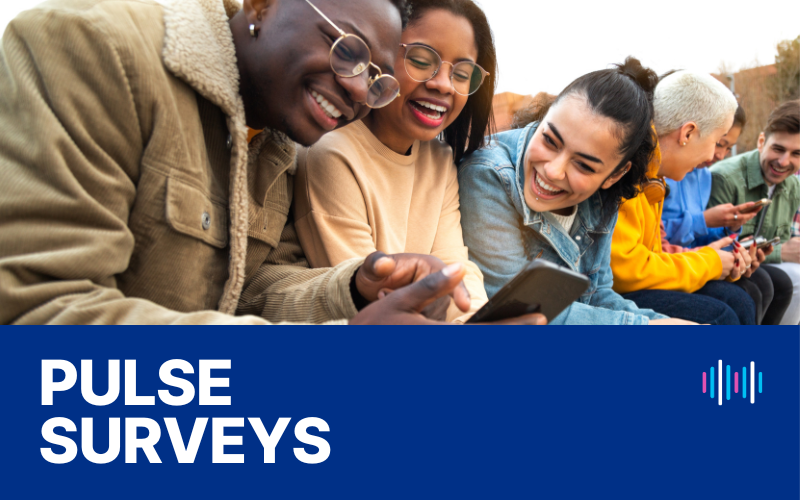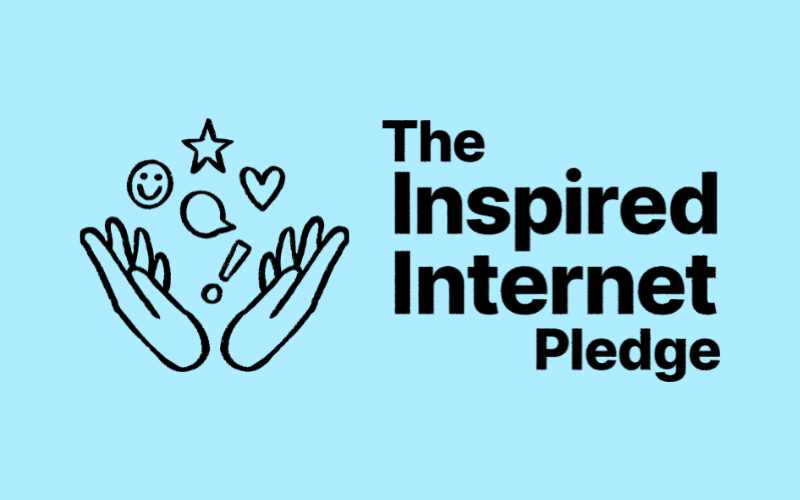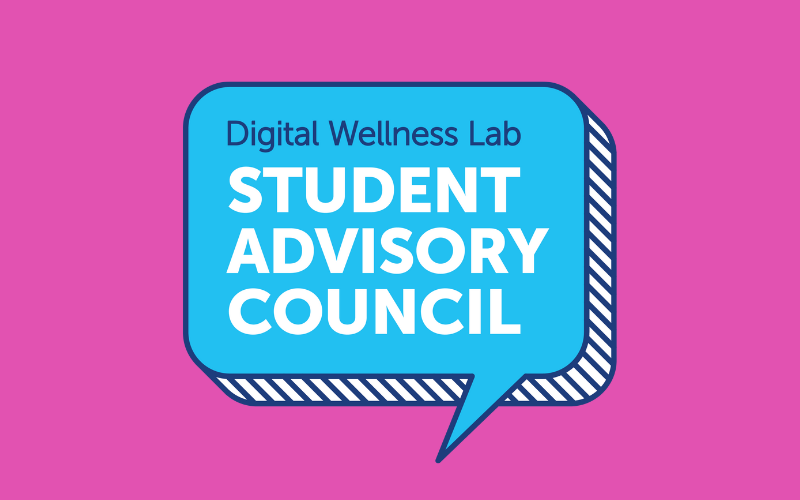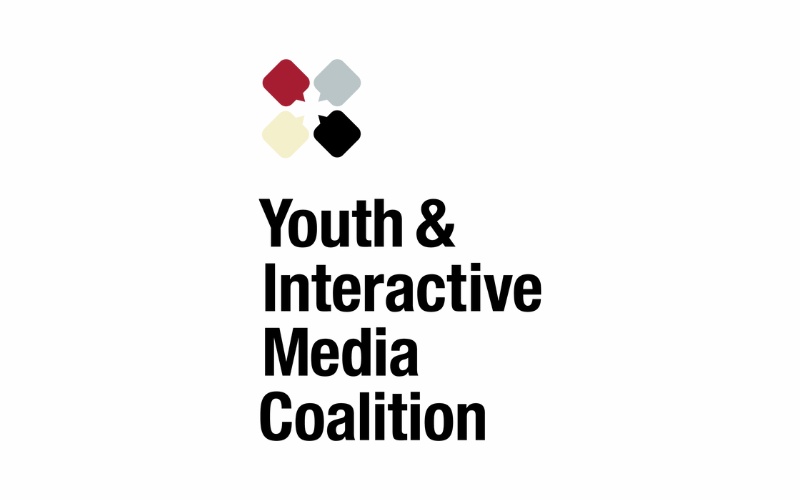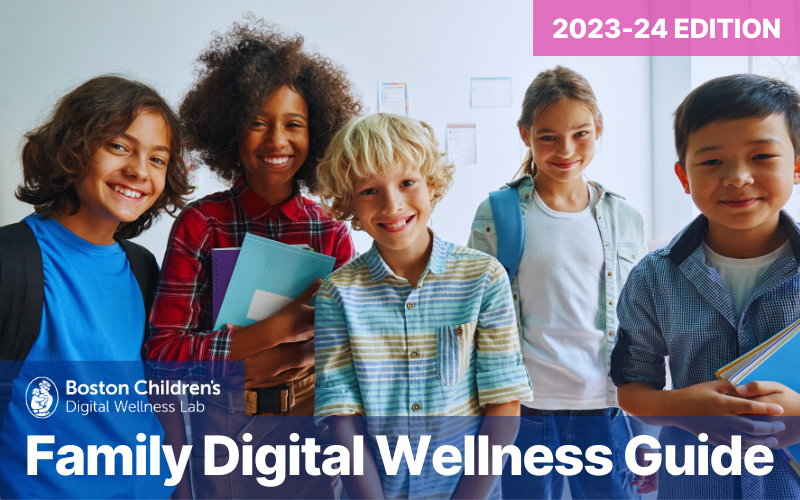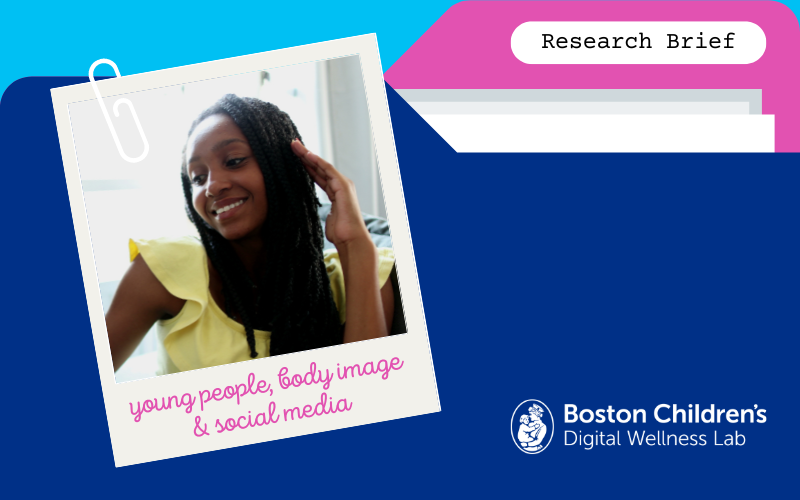In our rapidly changing digital landscape, the presence of social media has heightened fears about how new platforms and features might affect young people’s body image. Adolescents and young adults are at a developmental stage where social connection is extremely meaningful, and validation or exclusion by peers can have strong effects on mental health. In particular, body dissatisfaction may even lead some to develop disordered eating habits, with evidence suggesting a trend of earlier onset of eating disorders like anorexia nervosa (Favaro et al., 2019). It is therefore critical to understand the interplay between media representation of the body, young people’s media use, and their body image, as well as identifying specific features and/or knowledge that can protect young people from low self-esteem and body image disturbances.
In this research brief, we seek to explore the effects of popular media formats (e.g., social media) on the development of social comparison and body image, as well as steps that can be taken to protect children as they interact with traditional media and online social platforms.
Questions include:
- What does previous research about media and body image tell us about the effects of other popular media formats, such as magazines and television?
- What are the features of social media that may most affect young people’s likelihood to engage in social comparison, and in turn, their body image?
- What gender differences do we see in terms of research and related outcomes?
- What protective factors help support young people’s development of positive body image in the age of social media?
In order to encourage an inclusive understanding of these topics, we will also evaluate sociocultural factors that may moderate media effects and explore possible directions for future research.
A Brief History of Media and Body Image
While social media has become a prominent feature in the everyday lives of young people, both digital and analog media have been scrutinized for their effect on body image for decades. In the pre-social media decades, media research about body image effects focused primarily on magazines, television, and movies.
In 2003, researchers found that health and fitness magazines caused some of the highest maladaptive behaviors and poor body image results for both boys and girls (Botta, 2003). For adolescents and young adults who are at a developmental stage often characterized by heightened social comparison, these findings suggest that even media with the stated intention of emphasizing health can be damaging for body image. As early as six years old, girls may discuss fashion and health magazines in a way that emphasizes the appearance comparison between themselves and the perceived thin-ideal body of models and celebrities common in mass media (Dohnt & Tiggemann, 2006; Jones et al., 2004).
In addition to static magazine images, TV and movie depictions of characters have been shown to affect young people’s body image, including that of even the youngest viewers. When asked to identify a princess from a set of images, girls aged 5-6 chose significantly thinner adult figures than 3-4 year olds (Hayes & Tantleff-Dunn, 2010). However, when researchers studied the effects of children’s favorite princesses on their own body image, they found that those children whose favorite princesses had a more normative (rather than very slender) body type showed a positive relationship between pretend play, body esteem, and engagement in physical play (Shawcroft et al., 2023).
Researchers have found similar outcomes for older viewers. When an adolescent’s favorite television character is thinner, research indicates that they are more likely to compare themselves to that character, which can directly affect their body image (Te’eni-Harari & Eyal, 2015). Both gender and culture may play a role in how these images are internalized by adolescents. For adolescent girls, exposure to television commercials containing images of a thin-ideal woman led to greater body dissatisfaction, whereas for men exposed to commercials which highlighted the muscular ideal, these negative effects were seen later, during their college years (Hargreaves & Tiggemann, 2004, 2009).
Cultural differences play a role as well. Becker (2004) evaluated the impacts on body image and disordered eating in Fiji three years after Western-produced television was introduced to the region, reporting that the desire to emulate the thin characters from these shows was exacerbated by adolescent development: during adolescence, when peer social hierarchy is considered extremely important, girls experience social pressures that make them vulnerable to social comparison of thinness ideals, which in turn may lead to disordered eating habits. Research from the U.S. found that Latina adolescents who frequently viewed mainstream media which was less diverse had increases in negative body image; this was especially true for girls who primarily communicated in English, suggesting that Latina girls in more white-centric spaces may feel pressure to act and compare themselves to the white, ultra-thin media ideal (Schooler, 2008). Other researchers have found that Black girls were more likely to desire a moderate (not extremely thin or extremely curvy) body shape and were overall more satisfied with their body than white girls, but idealizing television characters still contributed to in disordered eating behaviors (Botta, 2000; Gentles & Harrison, 2006).
Regardless of the genre, the presence of a societally idealized body type can lead to significantly higher appearance dissatisfaction, especially among girls who identify strongly with those media models (Bell & Dittmar, 2011).
Impacts of Social Media on Body Image
The lessons learned from prior generations of media apply to our current web-enabled world. With the advent of social media, young people can now quickly and easily interact with peers while also gaining greater access to the lives of influencers and other celebrities. Many teens are now using social media platforms every day. In 2023, YouTube and TikTok — both visual social media platforms — were the top two apps used by teens: 71% used YouTube, and 58% used TikTok, every day (Anderson et al., 2023).
General Social Media Features
Nesi et al. (2018a, 2018b) introduced the theoretical transformation framework to describe how features of social media intersect with adolescents’ developmental stage and social interactions. This framework was later expanded to evaluate how these features of social media interact with adolescent girls’ body image and mental health. Some of these features included:
- visualness: emphasizes physical appearance, social comparison, and careful curation and editing of self-presentation;
- availability: makes it harder to break away from others viewing you, or the temptation to view others; and
- quantifiability: rewards those who have high numbers of likes and comments, which often focus on the appearance of the poster (Choukas-Bradley et al., 2022).
Overall, this access to curated content can be detrimental; our own research shows that 46% of American teens say that social media makes them feel a little or a lot worse about their body, compared to only 14% who say it makes them feel a little or a lot better (Bickham et al., 2022).
Many social media platforms also use targeted advertising techniques and allow content creators to feature sponsored content in their posts, meaning that children are exposed to advertisements from a young age. Even children not yet old enough to create their own accounts are frequently exposed to sponsored content on applications like YouTube, and the marketing of unhealthy food products is both common and likely to impact food choice preferences in younger children and tweens (Alruwaily et al., 2020; Coates et al., 2019).
As teens begin interacting with content on their own social media accounts, they see a wider variety of advertisements, some of which may promote dangerous steroids or weight loss supplements. While empirical research regarding the behaviors of adolescents in response to exposure to these advertisements is currently limited, research on the proliferation of dieting supplements and steroids through social media promotion expresses concern about how these products may be purchased and used (Cox et al., 2024; Pilgrim & Bohnet-Joschko, 2019). Anecdotal evidence suggests that the marketing of these products may be affecting teens who are concerned about their body shape, with some asking doctors about products like laxative teas after seeing them on social media (Youmshajekian, 2023). On TikTok, nutritionally focused posts are often created by white young adult women or adolescent girls, who may highlight food in relation to achieving thinness, thereby equating this with health (Minadeo & Pope, 2022). The introduction of increasingly-sophisticated algorithms can exacerbate the effects of damaging content, as a teen’s feed may fill with more and more related content the longer they watch (Harriger et al., 2022) While not peer-reviewed, explorations of algorithmic recommendations suggest that accounts of “vulnerable” teens (i.e. those liking content related to body image concerns) may be offered up dieting or eating disorder content on their personal feed quickly and consistently (Center for Countering Digital Hate, 2022). It is imperative for research to explore how advertising may encourage teens to try risky diet or muscle-building products and what can be done to prevent those outcomes, especially as discussion about weight loss drugs has become increasingly prevalent in social media.
Content Editing
One feature of social media is the ability for all users to easily edit images and videos before they post, without the need for professional skills or training. While many people do post unfiltered content, the tools for manipulation of photos and videos have become extremely sophisticated, which can make determination of realism difficult. Greater use of applications which prioritize highly visual content, such as Instagram, has been associated with body image and mental health concerns (Marengo et al., 2018). Adolescent girls who viewed manipulated Instagram photos reported lower body image following the exposure; this was especially true for girls who exhibited high levels of general social comparison (Kleemans et al., 2018). With pressure to match these curated presentations, adolescents may turn to using filters and editing tools to make their body smaller (or “more attractive”) and may seek reassurance from friends before posting publicly (Chua & Chang, 2016; Yau & Reich, 2018).
While there has been growing interest around adding disclaimers or tags to alert a social media user about edited content, preliminary research on the efficacy of these labels on advertisements suggests they are ineffective and possibly even result in more appearance scrutiny as the viewer is then drawn to placing increased focus on body parts featured in the image (Tiggeman, 2022). One unique aspect of social media is that many photos and videos were likely modified by the poster themselves, rather than a larger corporate entity, and unfortunately, self-disclosures of editing or curation to get the perfect photo may also be ineffective, and may actually lead viewers to form more negative opinions about the person in the photo (Fardouly & Holland, 2018; Livingston et al., 2020).
Celebrities, Influencers, and Body Image
In today’s social media landscape, celebrities have millions of followers across platforms, and the rise of the “influencer” has created a new form of celebrity. Influencers and other celebrities can financially benefit from engagement on social media, not only from views and comments but also through sponsored posts and corporate partnerships. For young people, the highly curated images from influencers can be damaging to body image, with younger girls and those with a higher BMI most affected by comparing themselves to influencers’ appearances (Pedalino & Camerini, 2022).
For teen boys and young men, following fitness influencers may have a mix of positive and negative effects. Photos and videos highlighting muscularity and appearance may lower the body satisfaction of the viewer and lead them to internalize this muscular ideal, in extreme cases leading to excessive exercise or use of steroids (Chatzopoulou et al., 2020; Tiggemann & Anderberg, 2020). However, some followers of fitness influencers may feel motivated to take steps to exercise and eat in healthy ways, which may increase self-confidence (Chatzopoulou et al., 2020). Since research has shown that fitness and health magazines may decrease body image instead of increasing wellness, fitness and health influencers may be the “new frontier” for this content. Future work should continue to explore ways to protect young people from unrealistic or unhealthy comparisons while still encouraging positive lifestyle changes that increase healthy physical activity and food choices.
The Body Positive Movement
Although social media can pressure users to post the highlights of their lives or portray them in an idealized fashion, there is a growing movement on social media to reject that pressure and share realistic images, videos, and experiences.
Body positive content on social media often seeks to depict a broad conceptualization of beauty, beyond the white, thin, female ideal (for a recent review, see Rodgers et al., 2022). However, research has found that body positive posts which gain traction on platforms like Instagram and TikTok may still center young, thin, white female bodies. On TikTok, an analysis of videos found only 32% of #bodypositivity videos portrayed larger bodies (Harriger et al., 2023), and on Instagram, 67% of images collected were of a white subject (Lazuka et al., 2020).
Despite a need for more diversity, the body positive movement can certainly have beneficial effects for young viewers, such as highlighting the importance of mental health and creating a socially supportive environment (Kelly & Daneshjoo, 2019). A recent experiment highlighted that for young women, viewing thin-ideal images was associated with decreased body appreciation, but viewing body positive content was associated with increased body satisfaction (Cohen et al., 2019). While researchers should continue to monitor the trends in this movement, it is clear that youth can benefit from social media posts which celebrate body diversity.
Can Social Media Literacy Protect Young People?
With research suggesting that social media comparison may damage body image, protective measures are a focus in the current research landscape, and there is already some evidence that media literacy skills can protect against body image deterioration. Researchers have evaluated the effects of existing media literacy skills in young people, as well as deployed media literacy programs which sought to directly teach about body image and interactive media.
Evaluation of Existing Media Literacy Skills
Beyond creating new materials, research has also evaluated how a young person’s existing media literacy skills can affect the relationship between social media and body image. This work is crucial, especially considering the wide variety of ways children may learn (or not learn) media literacy, whether through school, community organizations, parents, or through their own information-seeking.
Research on young women’s media literacy has found protective benefits to critically evaluating social media. College-aged women were less likely to internalize the thin-ideal from images posted to Instagram the more they believed the images were edited (Vendemia & DeAndrea, 2018). Young adolescent girls who reported being aware of filtering techniques and knowing that celebrity or influencer images may be retouched expressed greater body satisfaction and understanding of the less realistic nature of some social media posts; girls noted that these skills and self-assurance can be the result of a supportive school environment and positive parental influence (Burnette et al., 2017; Mahon & Hevey, 2021). While social media may generally have an effect on adolescent body image, overall media literacy knowledge may not provide as strong protection for boys and young men compared to girls and young women (Tamplin et al., 2018).
Learning Modules
Since media literacy curriculum requirements remain inconsistent across school districts, both within the United States and across the rest of the world, researchers have created new media literacy interventions to determine their effectiveness in minimizing the damage of body comparison to media imagery.
The interventions evaluated in this brief were frequently deployed in schools and consisted of materials which specifically highlighted the body image challenges students might face when on social media, tools for self-esteem development, and awareness of social comparison and unhealthy dietary behaviors (e.g. Bell et al., 2021; Gordon et al., 2021; Mahon & Hevey, 2023; McLean et al., 2017). These interventions were generally developed and/or implemented across majority-Western cultures, within highly industrialized areas such as Australia (Gordon et al., 2021; McLean et al., 2017) and Europe (Bell et al., 2021, 2022; Mahon & Hevey, 2023). Although general media literacy and body image interventions have been evaluated in the United States (e.g. Rohde et al., 2014), there is a dearth of research on social media literacy education in schools in the United States, despite body image disturbances being commonly discussed as a reason for limiting social media access for younger adolescents and growing levels of young people concerned about their body size (Wang et al., 2019).
The results of these studies suggest that formal media literacy interventions and learning opportunities may provide young people with some protection against body image disturbances and high levels of body comparison to social media images. McLean et al. (2017) created a three-lesson intervention for girls, which included such goals as decreasing upward social comparison on social media and reducing the frequency of appearance-related commenting on peers’ social media. Small to medium positive effect sizes were observed for body image and realism skepticism (i.e. questioning if a post reflects “real life”), and girls reported a reduction in dietary restraint even though dieting was not explicitly covered in the lesson material (McLean et al., 2017). Many other mixed-gender evaluations of programs like Digital Bodies (Bell et al., 2022), Body Talk in the Digital Age (Bell et al., 2021), Digital SMART (Social Media Adolescent Resilience Training; Mahon & Hevey, 2023), and SoMe (Gordon et al., 2021) were more mixed, with girls benefitting more than boys, who demonstrated few or no changes.
While the interventions did include measurement scales which evaluated drive for muscularity, there may be a need to develop more materials specifically addressing the body image concerns of boys (e.g. muscular-ideal) to see greater positive effects. Further research should be conducted to ensure the creation of culturally relevant materials, as some research appeared to have predominantly white samples (e.g. McLean et al. 2017; Gordon et al. 2021) or did not report racial or ethnicity data (e.g. Bell et al., 2021; Mahon & Hevey, 2023). Similarly, there is a need for more research with gender-diverse individuals to determine if these adolescents face specific body-image issues which are not discussed in existing learning materials.
Social Media Breaks
Outside of school-based education, researchers have also evaluated the efficacy of social media breaks on body image and self-esteem. One such study with teenage participants from the United States and Canada focused on female dancers, who often face intense pressure to remain lean. The researchers found that a three-day break from social media decreased body surveillance and shame while increasing self-esteem and self-compassion (Roberts et al., 2022). However, it is important to note that the girls evaluated their experiences within five days of finishing the break, so it is not entirely clear how long these benefits would last. Other broader research with adolescents taking shorter one-day breaks from social media has found limited benefits and evidence that this may actually decrease wellbeing (Przybylski et al., 2021), so it is crucial to evaluate the possible benefits and risks of these “digital detoxes”.
Conclusion
The development of social media has led to an increased focus in scholarship regarding its effects on body image. But it is clear that media effects on the body image of young people has been of interest for decades, and will likely continue to be a focus in media research. Dangers of social media include its focus on appearance and its constant accessibility — social media allows for constant comparison to both peers and media personalities such as celebrities. This can be difficult to navigate for those who have existing low body esteem or find themselves more likely to compare themselves to others. Additionally, girls may be at a heightened risk of negative effects of social media on body image due to prevalent societal pressures towards thinness.
Despite these risks, media literacy can likely provide a layer of protection against these damaging effects, especially for vulnerable populations such as girls and young women. Giving youth the opportunity to become equipped with the knowledge to navigate and evaluate the content they are seeing online can empower them and protect their mental health. With this in mind, it is critical that social media literacy be taught to young people, ideally before they are using social media. Lastly, while there has been a great interest in the unique challenges girls may face online in regards to their body image, research should strive to diversify their samples to capture cultural and gender differences in order to best create literacy frameworks which protect all young people.
This research brief was written by Kaitlin Tiches, MLIS, Medical Librarian and Knowledge Manager at the Digital Wellness Lab. For more information, please email us.

